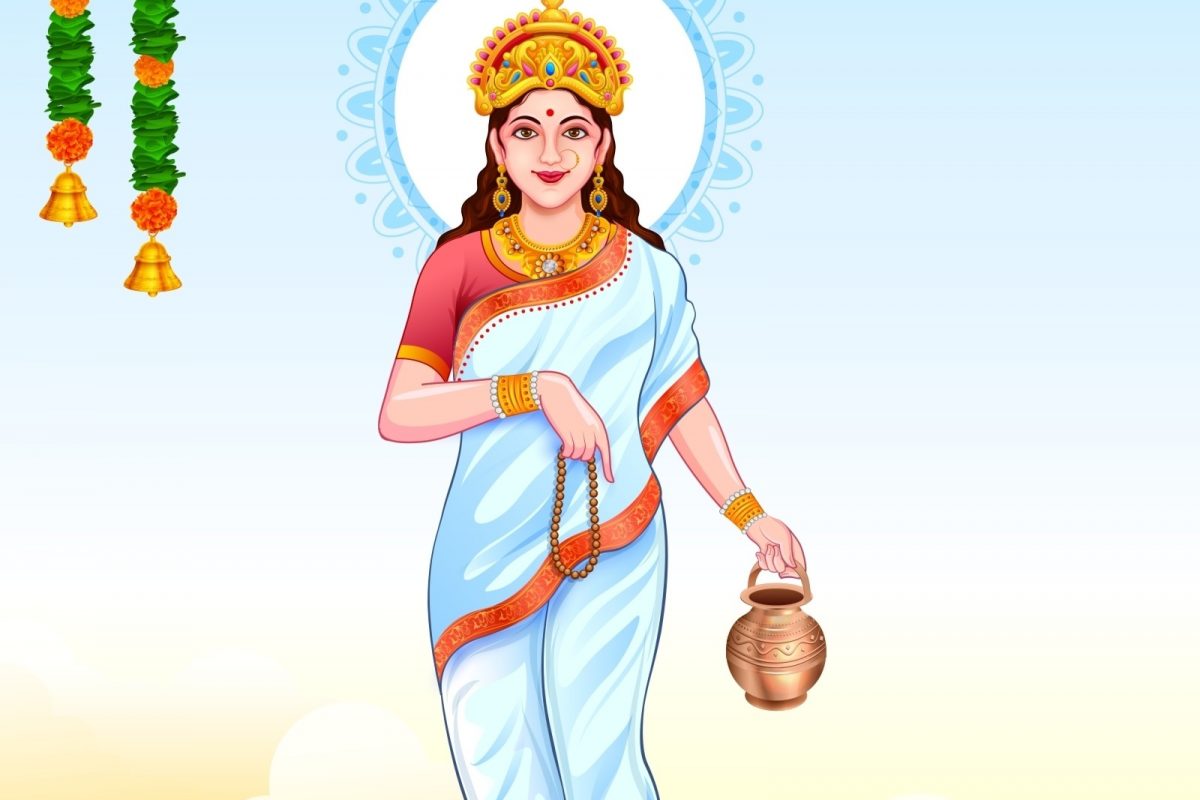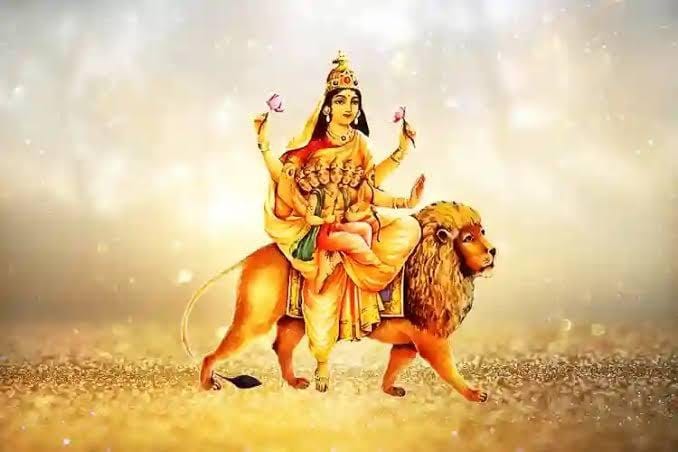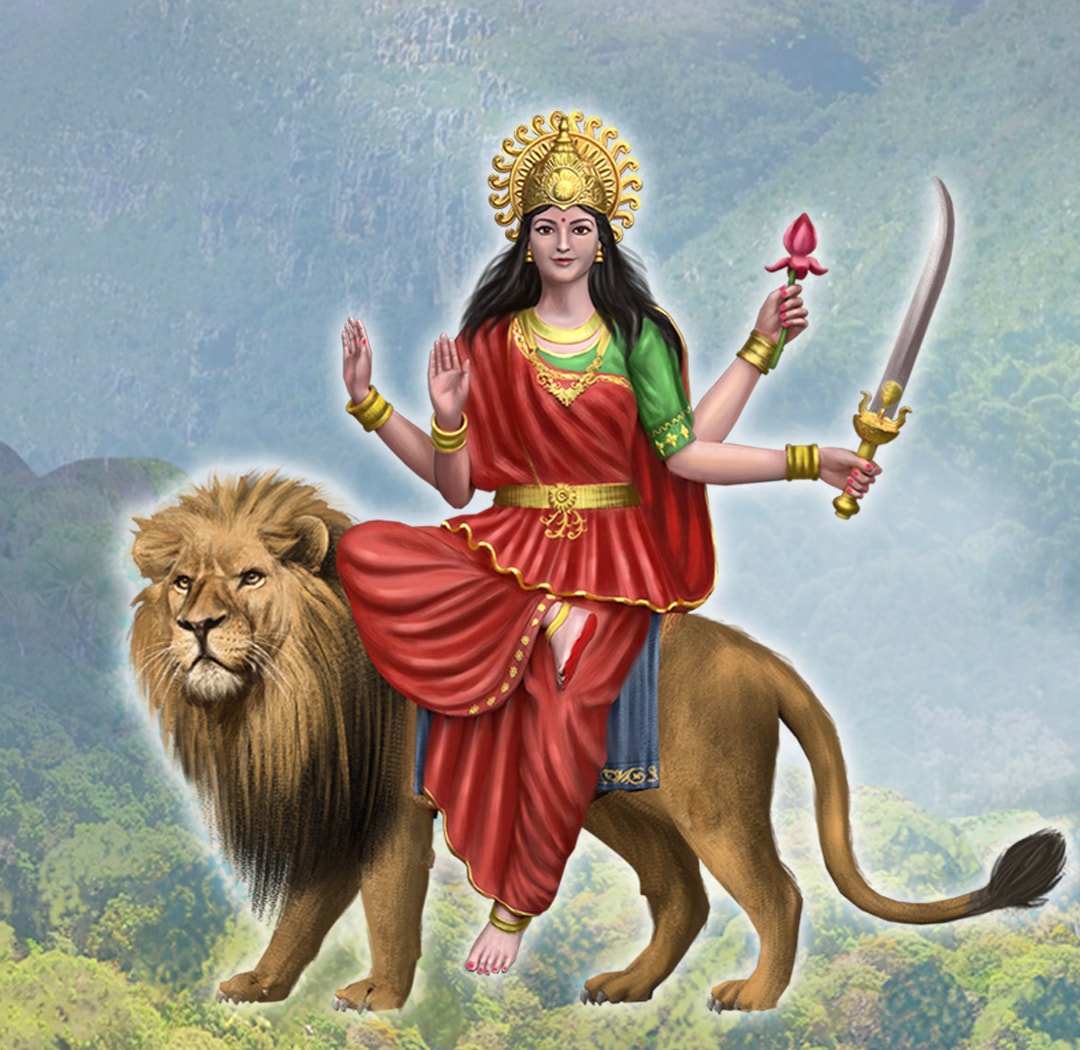Navaratri is an annual Hindu festival observed in honor of the goddess Durga, an aspect of Adi Parashakti, the supreme goddess. It spans over nine nights, celebrated first in Chaitra (March/April) and again in Ashvin (September–October). It is observed for different reasons and celebrated differently across the Hindu Indian cultural sphere. The most significant is the post-monsoon autumn festival called Sharada Navaratri.
 Goddess Durga, the central deity of Navaratri.
Goddess Durga, the central deity of Navaratri.
The word Navarātram means "a period of nine nights" in Sanskrit, nava meaning "nine" and ratri meaning "night". In the eastern and northeastern states of India, the Durga Puja is synonymous with Navaratri, wherein goddess Durga battles and emerges victorious over the buffalo demon Mahishasura to help restore dharma. In southern states, the victory of Durga or Kali is celebrated. In the western state of Gujarat, Navaratri celebrations are constituted by arti, followed by garba. In all cases, the common theme is the battle and victory of good over evil based on a regionally famous epic or legend such as the Devi Mahatmya. Celebrations include worshipping nine goddesses during nine days, stage decorations, recital of the legend, enacting of the story, and chanting of the scriptures of Hinduism. The nine days are also a major crop season cultural event, such as competitive design and staging of pandals, a family visit to these pandals, and the public celebration of classical and folk dances of Hindu culture. Hindu devotees often celebrate Navaratri by fasting. On the final day, called Vijayadashami, the statues are either immersed in a water body such as a river or ocean, or the statue symbolising the evil is burnt with fireworks, marking the destruction of evil. During this time preparations also take place for Deepavali (the festival of lights) which is celebrated twenty days after Vijayadashami.
 Vibrant celebrations across India.
Vibrant celebrations across India.
According to some Hindu texts such as the Shakta and Vaishnava Puranas, Navaratri theoretically falls two or four times in a year. Of these, the Sharada Navaratri near the September equinox (the autumn equinox in September–October) is the most celebrated and the Vasanta Navaratri near the March equinox (the spring equinox in March–April) is the next most significant to the culture of the Indian subcontinent. In all cases, Navaratri falls in the bright half (waxing phase) of the Hindu lunisolar months. The celebrations vary by region, leaving much to the creativity and preferences of the Hindu. Sharada Navaratri is the most celebrated of the four Navaratri, named after Sharada which means autumn. It commences on the first day (pratipada) of the bright fortnight of the lunar month of Ashvini. The festival is celebrated for nine nights once every year during this month, which typically falls in the Gregorian months of September and October. The exact dates of the festival are determined according to the Hindu lunisolar calendar.
A notable pan-Hindu tradition during Navaratri is the adoration of **Saraswati**, the goddess of knowledge and arts, celebrated through **Ayudha Puja**.
The festivities extend beyond goddess Durga and various other goddesses such as Saraswati and Lakshmi. Deities such as Ganesha, Kartikeya, Shiva, and Parvati are regionally revered. On Ayudha Puja (typically the ninth day), peace and knowledge is celebrated. Warriors thank, decorate, and worship their weapons, offering prayers to Saraswati. Musicians upkeep, play, and pray their musical instruments. Farmers, carpenters, smiths, pottery makers, shopkeepers, and all sorts of tradespeople similarly decorate and worship their equipment, machinery, and tools of trade. This tradition is particularly strong in South India, but is observed elsewhere too.
Nine Forms of Durga (Navadurga)
Day 1 – Shailaputri
Pratipada is associated with Shailaputri ("Daughter of Mountain"), an incarnation of Parvati. She is depicted as riding the bull, Nandi, and symbolizes action and vigor. She is also considered a reincarnation of Sati.
Day 2 – Brahmacharini

On Dwitiya, Goddess Brahmacharini ("Unmarried One") is worshipped for emancipation (moksha) and the endowment of peace and prosperity. She symbolizes bliss and calm, walking barefoot and holding a rudrakshmala and a kamandala.
Day 3 – Chandraghanta

Tritiya commemorates Chandraghanta, named after the half-moon on her forehead. She is the embodiment of beauty and symbolizes bravery.
Day 4 – Kushmanda

Goddess Kushmanda is worshipped on Chaturthi. Believed to be the creative power of the universe, she is associated with the endowment of vegetation on earth. She is depicted as having eight arms and sits on a tiger.
Day 5 – Skandamata

Skandamata, worshipped on Panchami, is the mother of Skanda (Kartikeya). She is depicted riding a ferocious lion, holding her baby, and symbolizes the transforming strength of a mother.
Day 6 – Katyayani

Katyayani, born to sage Katyayana, killed the buffalo-demon, Mahisa. Known as the warrior goddess, she rides a lion, has four hands, and is one of the most violent forms of Devi. Maha Shashti is observed on this day in eastern India.
Day 7 – Kalaratri

Considered the most ferocious form of Durga, Kalaratri is revered on Saptami. It is believed Parvati removed her pale skin to kill the asuras Shumbha and Nishumbha. She is depicted with enraged, fiery eyes and dark skin.
Day 8 – Mahagauri

Mahagauri, celebrated on Ashtami, symbolizes intelligence and peace. It is believed she gained a warmer complexion after a bath in the Ganga river. This day is a very important tithi and considered the birthday of Mahishasura mardini rupa of Chandi.
Day 9 – Siddhidatri
On Navami, people pray to Siddhidhatri ("Giver of Perfection"). She is believed to possess and bestow all types of Siddhis. Siddhidatri is also seen as the Ardhanarishvara form of Shiva and Shakti.
Day 10 – Dussehra or Vijayadashami
Vijayadashami is observed for different reasons and celebrated differently in various parts of the Indian subcontinent. In the southern, eastern, northeastern, and some northern states of India, Vijayadashami marks the end of Durga Puja, commemorating goddess Durga's victory against the buffalo-demon Mahishasura to restore and protect dharma. Dussehra, in Hinduism, is a holiday marking the triumph of Rama, an avatar of Lord Vishnu, over the 10-headed demon king Ravana, who abducted Rama's wife, Sita. The festival's name is derived from the Sanskrit words dasha (“ten”) and hara (“defeat”). Symbolizing the victory of good over evil, Dussehra is celebrated on the 10th day of the month of Ashvina (September–October). For many, it marks the beginning of preparation for Diwali, which occurs 20 days after Dussehra.
Religious Practices
Navaratri is celebrated in different ways throughout India. Certain people revere different aspects of Durga and some people fast while others feast. The Chaitra Navaratri culminates in Ram Navami and the Sharada Navaratri culminates in Durga Puja and Vijayadashami. In the past, Shakta Hindus used to recite Durga's legends during the Chaitra Navaratri around the spring equinox. For most contemporary Hindus, it is the Navaratri around the autumn equinox that is the major festival and the one observed. To Bengali Hindus and to Shakta Hindus outside of eastern and northeastern states of India, the term Navaratri implies Durga Puja in the warrior goddess aspect of Devi. In other traditions of Hinduism, the term Navaratri implies the celebration of Durga but in her more peaceful forms, such as Saraswati. In Nepal, Navaratri is called Dashain, and is a major annual homecoming and family event that celebrates the bonds between elders and youngsters with Tika Puja, as well as across family and community members.